Zekun Niu
Deep Learning Waveform Modeling for Wideband Optical Fiber Channel Transmission: Challenges and Potential Solutions
Jan 14, 2025



Abstract:Fast and accurate optical fiber communication simulation system are crucial for optimizing optical networks, developing digital signal processing algorithms, and performing end-to-end (E2E) optimization. Deep learning (DL) has emerged as a valuable tool to reduce the complexity of traditional waveform simulation methods, such as split-step Fourier method (SSFM). DL-based schemes have achieved high accuracy and low complexity fiber channel waveform modeling as its strong nonlinear fitting ability and high efficiency in parallel computation. However, DL-based schemes are mainly utilized in single-channel and few-channel wavelength division multiplexing (WDM) systems. The applicability of DL-based schemes in wideband WDM systems remains uncertain due to the lack of comparison under consistent standards and scenarios. In this paper, we propose a DSP-assisted accuracy evaluation method to evaluate the performance for DL-based schemes, from the aspects of waveform and quality of transmission (QoT) errors. We compare the performance of five various DL-based schemes and valid the effectiveness of DSP-assisted method in WDM systems. Results suggest that feature decoupled distributed (FDD) achieves the better accuracy, especially in large-channel and high-rate scenarios. Furthermore, we find that the accuracy of FDD still exhibit significant degradation with the number of WDM channels and transmission rates exceeds 15 and 100 GBaud, indicating challenges for wideband applications. We further analyze the reasons of performance degradation from the perspective of increased linearity and nonlinearity and discuss potential solutions including further decoupling scheme designs and improvement in DL models. Despite DL-based schemes remain challenges in wideband WDM systems, they have strong potential for high-accuracy and low-complexity optical fiber channel waveform modeling.
Low Complexity Joint Chromatic Dispersion and Time/Frequency Offset Estimation Based on Fractional Fourier Transform
Nov 07, 2024
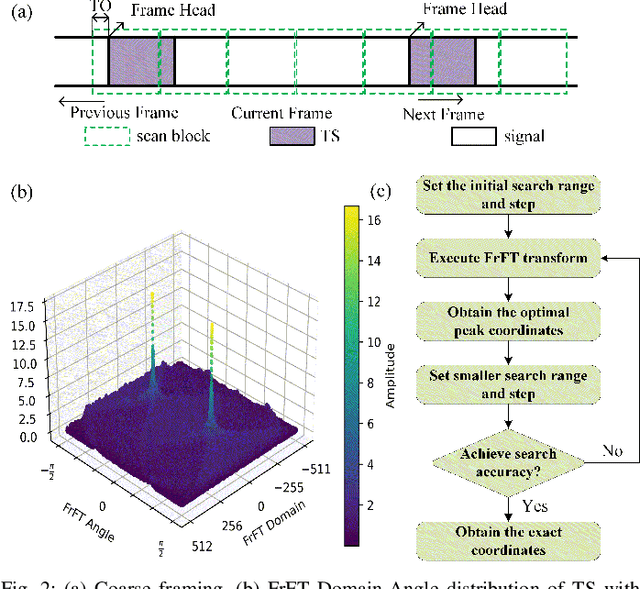
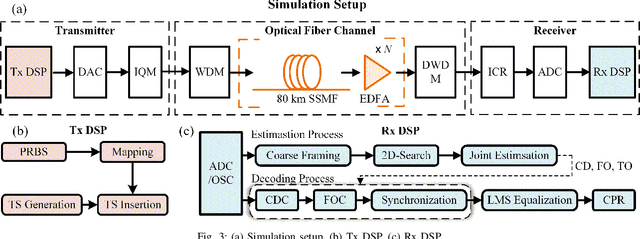
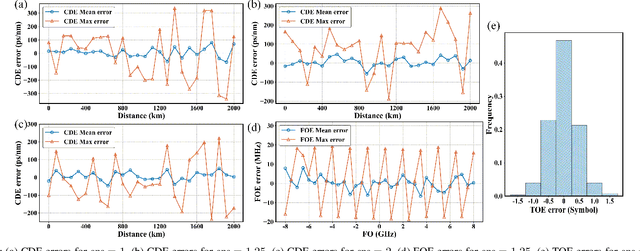
Abstract:We propose and experimentally validate a joint estimation method for chromatic dispersion and time-frequency offset based on the fractional Fourier transform, which reduces computational complexity by more than 50% while keeping estimation accuracy.
Improve the Fitting Accuracy of Deep Learning for the Nonlinear Schrödinger Equation Using Linear Feature Decoupling Method
Nov 07, 2024Abstract:We utilize the Feature Decoupling Distributed (FDD) method to enhance the capability of deep learning to fit the Nonlinear Schrodinger Equation (NLSE), significantly reducing the NLSE loss compared to non decoupling model.
Fast and accurate waveform modeling of long-haul multi-channel optical fiber transmission using a hybrid model-data driven scheme
Jan 18, 2022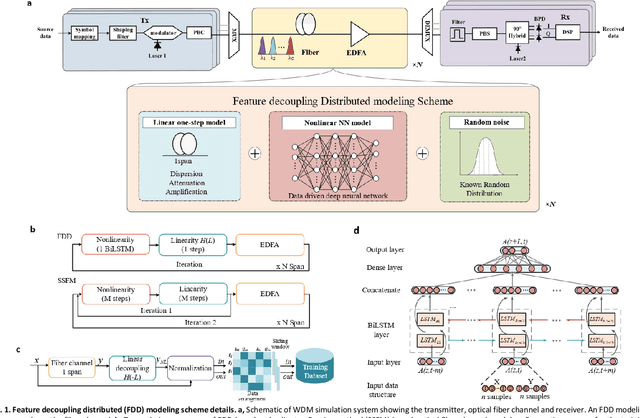

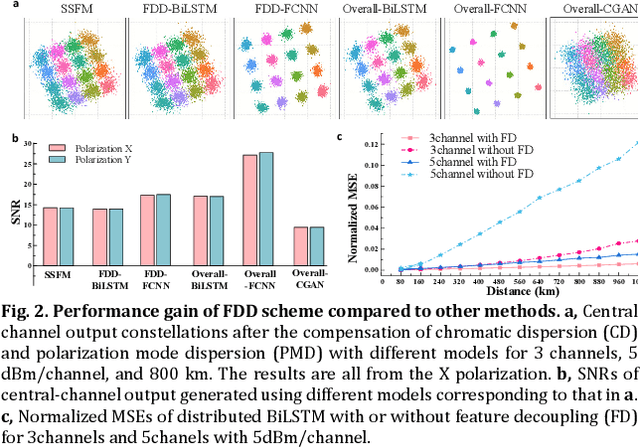
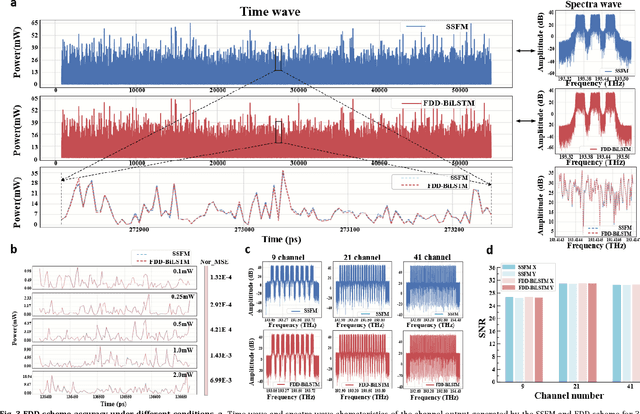
Abstract:The modeling of optical wave propagation in optical fiber is a task of fast and accurate solving the nonlinear Schr\"odinger equation (NLSE), and can enable the optical system design, digital signal processing verification and fast waveform calculation. Traditional waveform modeling of full-time and full-frequency information is the split-step Fourier method (SSFM), which has long been regarded as challenging in long-haul wavelength division multiplexing (WDM) optical fiber communication systems because it is extremely time-consuming. Here we propose a linear-nonlinear feature decoupling distributed (FDD) waveform modeling scheme to model long-haul WDM fiber channel, where the channel linear effects are modelled by the NLSE-derived model-driven methods and the nonlinear effects are modelled by the data-driven deep learning methods. Meanwhile, the proposed scheme only focuses on one-span fiber distance fitting, and then recursively transmits the model to achieve the required transmission distance. The proposed modeling scheme is demonstrated to have high accuracy, high computing speeds, and robust generalization abilities for different optical launch powers, modulation formats, channel numbers and transmission distances. The total running time of FDD waveform modeling scheme for 41-channel 1040-km fiber transmission is only 3 minutes versus more than 2 hours using SSFM for each input condition, which achieves a 98% reduction in computing time. Considering the multi-round optimization by adjusting system parameters, the complexity reduction is significant. The results represent a remarkable improvement in nonlinear fiber modeling and open up novel perspectives for solution of NLSE-like partial differential equations and optical fiber physics problems.
Optical Fiber Channel Modeling Using Conditional Generative Adversarial Network
Feb 28, 2020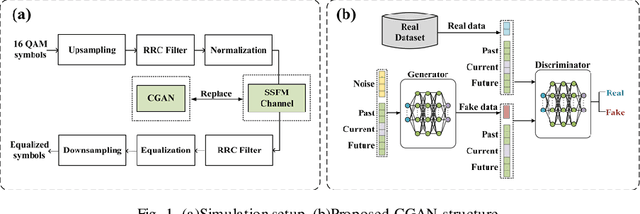

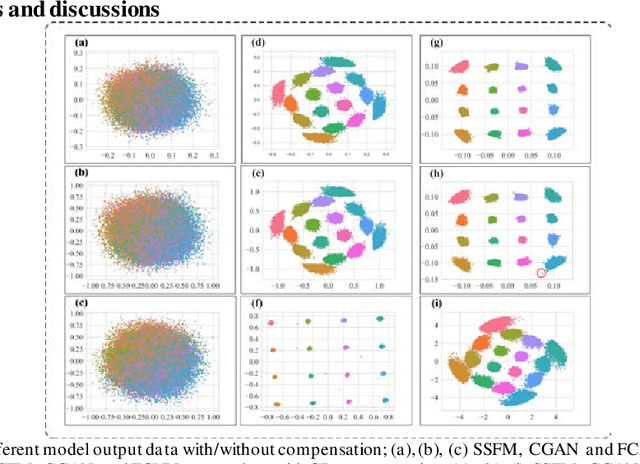
Abstract:In this paper, we use CGAN (conditional generative adversarial network) to model the fiber-optic channel and the performance is similar with the conventional method, SSFM (split-step Fourier method), while the running time is reduced from several minutes to about 2 seconds at 80-km distance.
 Add to Chrome
Add to Chrome Add to Firefox
Add to Firefox Add to Edge
Add to Edge